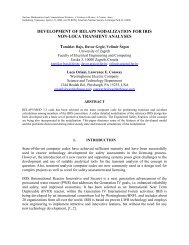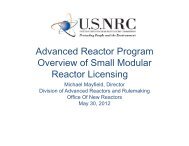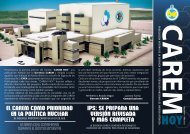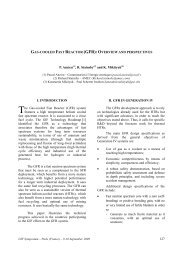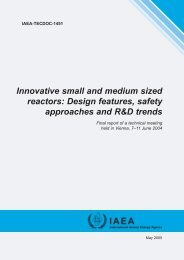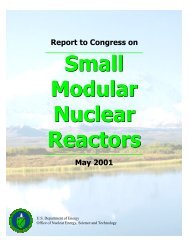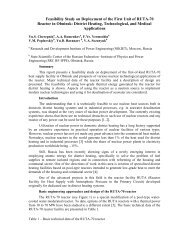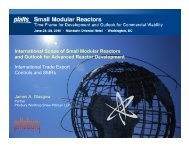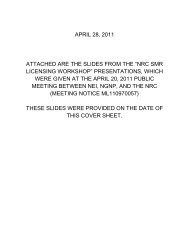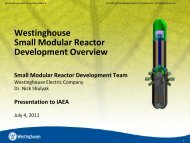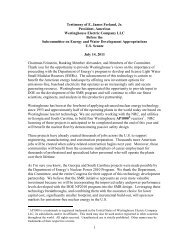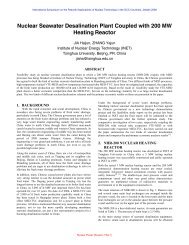Question and Answer Session for ENW.pdf - UxC
Question and Answer Session for ENW.pdf - UxC
Question and Answer Session for ENW.pdf - UxC
Create successful ePaper yourself
Turn your PDF publications into a flip-book with our unique Google optimized e-Paper software.
Q&A <strong>Session</strong> <strong>for</strong> Energy Northwest Presents:<br />
NuScale: Responsible Options <strong>for</strong> Exp<strong>and</strong>ing Northwest Nuclear Power<br />
Q: How does cost compare to other resources<br />
A: The per kWh bus-bar cost of power from a st<strong>and</strong>ard NuScale plant compares favorably to<br />
published numbers <strong>for</strong> new, large scale, single shaft nuclear plants.<br />
_________________________________________________________________<br />
Q: Paul/Jack, so you have a fixed O&M, variable O&M <strong>and</strong> heat rate <strong>for</strong> the NuScale<br />
technology<br />
A: NuScale currently projects O&M costs at $1.37 cents per kWh.<br />
_________________________________________________________________<br />
Q: Can you please speak to the refueling cycle, the costs <strong>for</strong> refueling <strong>and</strong> any disposal/storage<br />
costs of the removed fuels.<br />
A: Each NuScale module is individually taken out of service <strong>for</strong> about 14-days, once every two<br />
years <strong>for</strong> NRC required inspections <strong>and</strong> tests, <strong>and</strong> <strong>for</strong> refueling. The majority of the work related<br />
to refueling, inspections <strong>and</strong> tests is conducted by permanent plant staff instead of temporary<br />
workers so most of the associated costs are already included in O&M estimates.<br />
_________________________________________________________________<br />
Q: Dave, does the requirements <strong>for</strong>ecast take into account the current recession (especially in<br />
CA)<br />
A: The NWPCC 5 th Plan was prepared be<strong>for</strong>e the full onset of the economic crises. The 6th Plan<br />
is being prepared <strong>and</strong> is taking into consideration the current economic environment of the<br />
Western United States.<br />
_________________________________________________________________<br />
Q: Would plants be built <strong>for</strong> maximum capacity but only start with one + module(s)<br />
A: The scalable nature of the NuScale design offers flexibility in determining the ideal plant size.<br />
An owner, <strong>for</strong> example, has the flexibility to initially plan on a plant with three or four modules<br />
then decide during construction to add one or two more modules prior to project completion.<br />
_________________________________________________________________
Q&A <strong>Session</strong> <strong>for</strong> Energy Northwest Presents:<br />
NuScale: Responsible Options <strong>for</strong> Exp<strong>and</strong>ing Northwest Nuclear Power<br />
Q: What is the minimum size plant that is still economical<br />
A: The base design is <strong>for</strong> a 12 module (480 MWe) power plant that can be built in two phases<br />
with each phase able to accommodate six modules. NuScale is not proposing to design a plant<br />
with less capacity <strong>and</strong> it would not likely prove economical in the Pacific Northwest. There are<br />
locations, especially where electric systems rely heavily on diesel oil <strong>for</strong> generation, where a<br />
smaller configuration <strong>for</strong> a NuScale power plant makes sense <strong>and</strong> could lower costs to<br />
consumers.<br />
_________________________________________________________________<br />
Q: Roughly how do costs scale by size i.e. how would cost per KW installed <strong>for</strong> a 120 MW<br />
plant compare to a 480 MW<br />
A: The economics of different configurations needs to be evaluated on a case by case basis.<br />
NuScale is implementing a number of strategies to enhance the economics <strong>for</strong> plants that start<br />
out with fewer modules. The decision to design the plant so that it is built in two phases, each<br />
accommodating six modules, is an important example.<br />
_________________________________________________________________<br />
Q: What if you reduced the number of steam turbines from 12 to 4 Would that reduce the<br />
costs Need to weigh shaft risk vs costs.<br />
A: NuScale is focused on ensuring simplicity in design, construction <strong>and</strong> operation. It carefully<br />
evaluated the merits of having two or more modules supplying steam to a single turbine. The<br />
increased complexity in licensing, design, operations <strong>and</strong> maintenance, however, outweighed<br />
the potential benefits.<br />
_________________________________________________________________<br />
Q: Can you elaborate on what is meant by the NuScale technology meeting dispatchable<br />
characteristics Do you mean to say that NuScale technology may be operated at variable<br />
power outputs to accommodate fluctuations by renewables<br />
A: NuScale plants are designed as base load power plants but can meet the need <strong>for</strong> load<br />
shaping. Overall power output from a plant can be reduced by shutting down individual 40 MWe<br />
modules or reducing the power output from multiple modules. NuScale estimates that the power<br />
output of individual modules can be increased at a rate of approximately five percent, per hour.<br />
_________________________________________________________________
Q&A <strong>Session</strong> <strong>for</strong> Energy Northwest Presents:<br />
NuScale: Responsible Options <strong>for</strong> Exp<strong>and</strong>ing Northwest Nuclear Power<br />
Q: Would we be able to use previously approved plant site that was not completed<br />
A: Some of the existing infrastructure can be used <strong>for</strong> the NuScale project. We will not be able<br />
to use the existing Energy Northwest Site1 reactor building in the project, but some of the<br />
support buildings <strong>and</strong> the onsite electrical connection will save some overall cost of the project.<br />
_________________________________________________________________<br />
Q: What hurdles do we have to cross to get approval from the State of Washington Voter<br />
approval<br />
A: Any energy project exceeding 350 MWe, would require a local vote open to the utility’s<br />
ratepayers <strong>for</strong> the intent of approving or disapproving taking on new debt by a utility typically<br />
through bond sales. It does not require an open statewide vote. The number of Energy<br />
Northwest members <strong>and</strong> their geographic distribution is such that virtually every region of the<br />
state will be asked to vote. An up or down vote only affects the utility district where the vote is<br />
taken. Under the state statute the JOA needs a simple majority to go <strong>for</strong>ward with the project.<br />
_________________________________________________________________<br />
Q: Where on your website will the presentation <strong>and</strong> Q&As be<br />
A: http://www.energy-northwest.com/generation/options.php<br />
_________________________________________________________________<br />
Q: What's a good estimate <strong>for</strong> the cost of fuel <strong>and</strong> fuel disposal And what's your opinion on<br />
how long it will take the Feds to get a disposal site operating<br />
A: U.S. policy on managing used fuel <strong>and</strong> permanent disposal is changing under the new<br />
administration. It appears that plans <strong>for</strong> the permanent repository at Yucca Mountain in Nevada<br />
will be cancelled. Energy Secretary Chu is assembling a blue ribbon panel to study <strong>and</strong><br />
recommend a future strategy. A key question is whether to treat used fuel as waste <strong>and</strong> dispose<br />
of it permanently, or to view it as a valuable resource that can be recycled <strong>and</strong> reused in power<br />
plants. The most likely outcome of the current review is interim storage of used fuel in dry casks<br />
at centralized repositories. NuScale is designing its plants so that used fuel is first stored in a<br />
spent fuel pool that is below ground level, then moved to dry casks <strong>and</strong> stored adjacent to the<br />
plant.<br />
_________________________________________________________________



